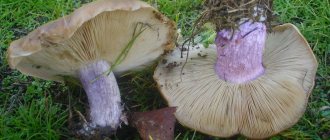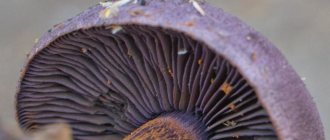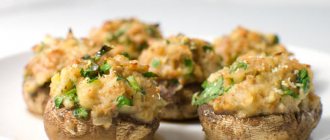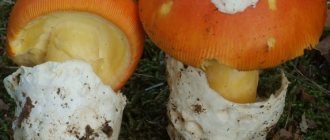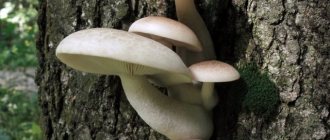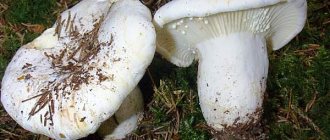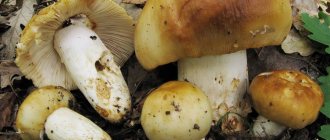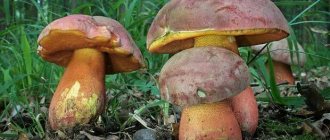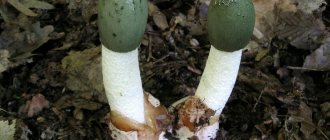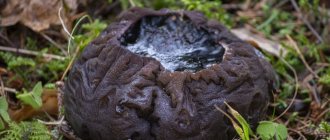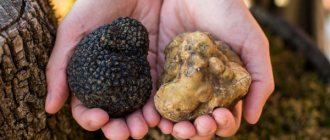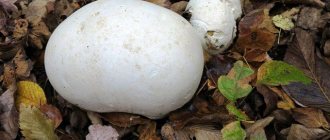Bluelegs, one of the subspecies of row mushrooms, are quite common in Russia. In addition to the official name “lilac-legged row”, this mushroom is also found under the names “podtavnik”, “blue root”, “lilac-legged”. This subtype of row is distinguished by an unusual anise aroma and excellent increased taste characteristics.
The bright purple color of the stem prevents it from being confused with poisonous mushrooms. And its inherent meatiness and juiciness are ideal qualities for preparing bluelegs in a variety of ways. But, if everything is clear with frying or drying, then not every housewife is familiar with the nuances of pickling such fruits.
Bluefeet: important information
This fruit is not just tasty, but also extremely healthy. Introducing it into a regular diet increases the body’s immunity, stops the development of pathogenic microflora, and stimulates the functioning of the cardiovascular system. It also becomes important for cleansing the liver and removing toxins from internal organs. Bluefoot stabilizes blood pressure and corrects blood sugar levels.
It has been established that bluelegs is also a good prophylactic for preventing the development of cancer.
Blueleg is a southern mushroom, but it can also be found in the central regions of our country right up to the Moscow region
The healing abilities of the mushroom are explained by the rich presence in its composition of a complex of vitamins and a number of important microelements: manganese, iron, zinc, calcium, phosphorus, potassium and magnesium. The energy value of the purple stalk is close to that of meat products. Therefore, this fruit should not be neglected and be sure to include it in your own menu.
Where can you pick mushrooms?
Bluelegs usually choose pastures or open meadows as their habitat. Sometimes they come across them very close to houses, near farms and compost ditches. In the forests it is worth looking for these gifts of nature under deciduous trees. In the southern regions, Russians harvest two rich harvests of bluelegs per season - in spring and autumn.
When to go harvest
It is best to collect mushrooms during the off-season (autumn or spring). The most active growth of bluelegs begins after a rainy period at air temperatures up to +10⁰С. Harvesting a rich harvest is quite simple - bluelegs grow in colonies, forming a kind of circular line.
Expert opinion
Melnikov Vladimir Mikhailovich
Knows 1000 ways to cook, pickle and marinate any types of mushrooms
It is better to collect bluelegs after rain, but in completely dry weather. Wet fungus becomes unpleasant and slimy to the touch.
How not to make a mistake
Due to its specific bright color, the purple stalk is difficult to confuse with other mushroom varieties. But there are some types of similar mushrooms.
For example:
- Row purple
Another type of edible fruit of the common row family. The only difference between them is the color of the cap. If the purple stalk has a purple cap color, then the purple row has a more saturated color, bright, close to purple.
- Gossamer violet
It is also a safe mushroom, but with different taste characteristics. It is distinguished by the presence of a peculiar veil (it is located under the cap) and a grayer color of the upper part of the fruit.
- White-violet cobweb
But this mushroom is extremely dangerous and toxic. It can be distinguished by its light yellow flesh when the stem is broken. It occasionally contains purple inclusions. Gives off toxicity and a sharp, repulsive odor.
Habitat and appearance
This variety of mushrooms can be found almost everywhere. In the Southern Hemisphere, you can even harvest two crops. It can easily tolerate light frosts down to -4°C. Harvesting takes place from August to November. These mushrooms love fertile soil, and therefore they can often be found on manure heaps, as well as in forest belts and under coniferous trees. They grow in “families” and in one place, which mushroom pickers take advantage of.
You can also meet them in garden plots. Under favorable conditions, a good harvest can be harvested. Bluelegs are valued for their ease of preparation and light fruity aroma. Each mushroom has its own differences.
Some inedible mushrooms “disguise” as their relatives, and therefore you need to know quality mushrooms “by sight” so as not to harm your body.
Distinctive features of blue legs:
- The leg is cylindrical in shape with a blue tint and up to 10 cm high.
- The smooth surface of the cap has a white tint and, under favorable conditions, can reach 30 cm in diameter.
- The pulp has an unobtrusive fruity aroma and is very meaty.
- Under the cap there is a lamellar structure. It can be either white or yellowish, and even slightly olive.
Preparing mushrooms for pickling
How do you like to pickle mushrooms?
TraditionallyExperimenting
Bluelegs are conditionally edible mushrooms and require careful preliminary preparation. Mushrooms must be young, not wormy, not broken, and free of soil and leaf debris.
Preparation includes the following steps:
- Wash the collected mushrooms thoroughly under running warm water, but no more than a quarter of an hour, otherwise the mushroom will lose its inherent aroma.
- Leave small fruits untouched, and cut large ones into several small pieces.
- If you decide to marinate the legs, then remove the top layer from them.
- Place the mushrooms in a large saucepan, add salted water and boil for 20-25 minutes, periodically skimming off the foam.
- The bluefish will be ready for further marinating as soon as they all sink to the bottom of the pan during cooking.
- Pour out the broth and leave the mushrooms in a colander for a while to get rid of excess liquid.
Collected bluelegs cannot be stored raw for a long time. They must be processed within 4-5 hours after assembly - this type of rows quickly deteriorates.
Where they grow, in what forests and when to collect
Myceliums are suitable for temperate climates. In Russia, they mainly grow in the European part of the state. You can find bluelegs in any type of planting. Unlike many other forest species, it is not characterized by attachment to certain trees.
Soil is much more important to her. Lilac-legged rowers prefer nutritious soil, so the places where they grow are usually rich in humus. Mushrooms can be found in old pastures and barnyards.
Myceliums are located in large groups, forming entire colonies. The fruiting period is very long. The bluelegs season begins in April and continues until the first frost.
Many mushrooms can only be collected in sunny meadows. Experienced mushroom pickers advise going for bluelegs on good days. In wet weather, the fruits are very slippery and difficult to pick. Preference should be given to young mushrooms.
The most delicious recipes for pickled mushrooms
Bluelegs can be pickled in various ways. They turn out equally well with both hot and cold versions of the marinade. You can prepare the blue root according to several recipes in order to subsequently evaluate the dish and choose your favorite.
Traditional marinating
This recipe is a classic in Russian cuisine. Cooked mushrooms are especially aromatic and crispy. This dish will be a real decoration for any holiday table.
What is necessary:
- Mushrooms: 1 kg.
- Water: 500 ml.
- Salt: 50-55 g.
- Sugar: 60-65 g.
- Laurel: 2-3 leaves.
- Black pepper: 12 peas.
- Allspice: 6-7 peas.
- Leaves of oak, cherry and currant.
- Garlic: 1 head (medium).
- Table vinegar: 50-55 ml.
Preparation:
Place blueberries in a deep container, add water, add pepper, sugar, plant leaves, salt and bay. Bring to a boil, turn off the heat and slowly boil the mushroom mass for about 10 minutes. During this time, peel the garlic and chop it finely. Mix in mushrooms and add vinegar. Let the marinade simmer for about a quarter of an hour and remove from the stove. Pour the mushroom mixture into sterilized glass jars, close them, cover with a blanket and leave until cool.
Expert opinion
Melnikov Vladimir Mikhailovich
Knows 1000 ways to cook, pickle and marinate any types of mushrooms
Bluelegs are large mushrooms; one specimen can grow up to 0.5 kg. But when cooked, they significantly decrease in size.
Bluelegs “with pepper”
This recipe is for those who love spicy cuisine. This snack goes great with alcohol. A piquant and spicy dish will be a good addition to friends' gatherings.
Required:
- Bluefoot: 2 kg.
- Water: liter.
- Allspice: 6-8 peas.
- Salt: 20-25 g.
- Citric acid: 2-3 g.
- Garlic: medium head.
- Chili pepper (bitter): 1 pod.
Manufacturing:
Pour water over the mushroom mixture, boil and let simmer for 10-15 minutes. At this time, slice the garlic into thin layers and add to the boiling mushrooms. Cut the chili pepper (along with seeds) into slices and also add to the broth. Then gradually add allspice, citric acid and salt. Let the mixture cook for another half hour. Place the finished mushrooms in jars, pour hot brine, wrap them in a terry towel and leave to cool.
Marinated assorted vegetables and mushrooms
This recipe is delicious and perfect as a base for mushroom salad. Also, rows marinated in this way can be fried and consumed as a nutritious and healthy side dish.
For the brine you need:
- Mushrooms: 1-1.5 kg.
- Wine vinegar: 300 ml.
- Water: 200 ml.
- Leeks: 2-3 pcs.
- Carrot: 1 pc.
- Tarragon and bay leaf: to taste.
- Salt: 15-20 g.
- Lemon fruit zest.
- Sugar: 10-15 g.
Preparation:
Blanch the bluefish in boiling water for about 5 minutes, then drain through a sieve and leave to drain excess liquid. At this time, prepare the carrots: rinse and chop into cubes. Add leeks, chopped into rings. Pour tartaric acid over the vegetables and leave for 5-6 minutes. Place the mushrooms in a saucepan, add water, pickled vegetables and other spices. Wait for it to boil and cook over low heat for 10-15 minutes. Transfer the prepared mushrooms into glass jars. Let the brine simmer for another 10 minutes and cool. Pour the cooled marinade into the prepared jars with mushrooms, close them and leave to cool (at room temperature).
Expert opinion
Melnikov Vladimir Mikhailovich
Knows 1000 ways to cook, pickle and marinate any types of mushrooms
If older mushroom fruits are used for pickling, they should first completely remove the spore-bearing layer of the cap. Mature spores are not digested by the human body and can cause intestinal colic.
The rows are fragrant
The recipe for this dish includes cloves. A specific spice gives pickled mushrooms a special piquancy and aroma. When cooking, you should spread the mushroom mixture loosely between the jars so that there is enough space for the marinade. This will make the mushrooms much tastier.
What you will need:
- Bluefoot: 1-1.2 kg.
- Water: liter.
- Salt: 20-25 g.
- Sugar: 15-20 g.
- Table vinegar: 45-50 ml.
- Bay leaf: 2-3 pcs.
- Allspice: 6-7 peas.
- Black pepper: 8-9 peas.
- Cloves: 3-4 buds.
Preparation:
Pour the prepared blue legs with warm water, put on the stove and boil. Simmer over low heat for 20 minutes. Add all the ingredients (except vinegar) to the liquid and boil for about 10 minutes, remembering to remove the foam. Then pour in the acid and simmer for a few more minutes. Remove from the stove, pour the mixture into jars, pour in the hot marinade and seal tightly. Cover with a thick cloth and leave to cool.
Expert opinion
Melnikov Vladimir Mikhailovich
Knows 1000 ways to cook, pickle and marinate any types of mushrooms
You can try bluelegs made according to this recipe after 4-5 days.
Cold marinating
Another original option for preparing bluelegs. The mustard used in the recipe will give the dish a particularly piquant taste and alluring aroma. And adding horseradish will give the taste an unusual bitterness and tartness.
What you will need:
- Mushrooms: 2 kg.
- Water: liter.
- Garlic: 4 cloves.
- Salt: 100 g.
- Fresh horseradish leaves: 3-4 pcs.
- Mustard beans: 15 g.
- Black pepper: 10-12 peas.
Preparation:
Boil the mushrooms in salted water for about half an hour and pass through a sieve to remove excess liquid. Place horseradish leaves at the bottom of sterilized jars. And then lay out the mushrooms in layers, alternating them with finely chopped garlic, pepper, salt and mustard. Press down the last laid layer tightly and close the containers with lids. Leave in a cool place. And after 1-1.5 months you can already take the first sample.
Expert opinion
Melnikov Vladimir Mikhailovich
Knows 1000 ways to cook, pickle and marinate any types of mushrooms
Bluelegs prepared using the cold brine method are stored at a temperature of +2-10⁰С. In warmer conditions, the mushrooms will quickly deteriorate and become moldy. And in the cold they will darken and completely lose their taste.
Useful tips for housewives
On average, mushrooms can be stored for up to 2 years without loss of taste.
Bluelegs are unusual mushrooms. When marinating them, you can achieve different, and sometimes unusual, taste sensations.
To do this, you should learn about some tricks:
- To obtain crispy mushrooms, plant leaves are added to the marinade: currant, oak, walnut or cherry and horseradish.
- If pickled bluelegs are boiled for a few minutes, they can be used as separate hot dishes or salads.
- Pickled fruits will not become moldy ahead of time if you cover them on top (before sealing the jars) with vegetable oil.
- But even if the pickled bluelegs become moldy, you should not throw them away, rinse them well, remove completely spoiled fruits and fill them with freshly prepared brine.
Pickled mushrooms are stored in a dark place at a temperature of +8-15⁰С. The ideal place is underground, cellars, basements, cool storage rooms. When opening the jar, the contents should be consumed within 2-3 days (if stored in the refrigerator - within a week). The more vinegar used in the marinade, the longer the pickled rows can be kept.
